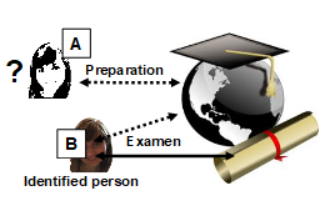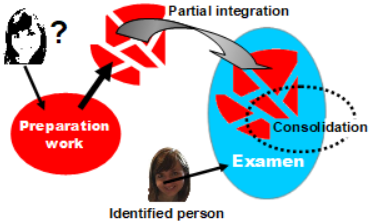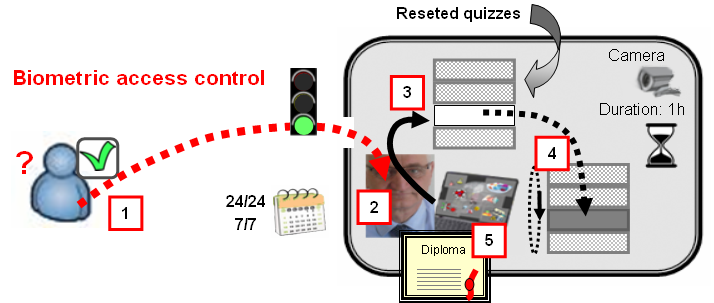AVANST Examination Procedure
The preparation quizzes are passed one after the other, when you want, from where you want,
you are authorized to make you help by whom you want.
But, into final, the results of the examination are allotted to you in an undeniable way.

 [A]. The procedure requires an user account connection but does not require a checking of the behavior, nor even the identification,
of the person who prepares the examination.
[A]. The procedure requires an user account connection but does not require a checking of the behavior, nor even the identification,
of the person who prepares the examination.
[B]. The effective identification of the candidate who passes the examination is necessary.
This identification can be done at the time of the access to a physical space controlled (as explained hereafter),
or to the opening of a controlled virtual space dedicated to the examination.
If the candidate did not practise the quizzes of preparation sufficiently, and/or if it understood and did not retain the principal elements of them,
it will not be able to make a success of its examination ;
The process establishing an original functional link between the results of preparation to the examination and the procedure
activated during the timed final examination.
Phase 1. Preparation to the examination

The phase of preparation to the examination uses the process of the assisted progression.
[1]. The future candidate must pass a phase of preparation to the examination before the final stage of examination itself.
The accesses to the quizzes of preparation are done by opening sessions by using a personal account.
The amount of sessions is not limited.
The candidate reaches the quizzes when he wants, from where he wants, he can be made help by which he wants.
[2]. The preparation to the examination is divided into series of quizzes intercalated with phases of consolidation.
SeeAssisted Progression
The preparation to the examination must be done within the time limit by the inspector; 2 months for example.
The effective duration of the preparation to the examination is variable according to the candidates.
It depends on expert testimonies, assiduities, the feeling to be ready for the examination, of the workload:
the preparation to the examination is generally done in parallel with the other university or professional activities of the candidate.
Administrative rebootstrapping of the results

Before the final examination, one of the quiz previously successful in phase of preparation, taken randomly, has its score set to zero.
The scores of the other successful quizzes are established with scores just higher than the defined passing scores.
Phase 2. Final examination

[1].The candidate is invited to go in a space dedicated to the final stage of examination.
The person who wants to penetrate within the space of examination is physically identified.
The biometric systems of facial recognition or print recognition make it possible to do without a watchman and to open the access to the space of examination
7 days over 7, 24 hours on 24.
[2]. The candidate opens a session by using his personal account already used in the phase of preparation to the examination.
The opening of the session starts a timer: the pages of quizzes having already been seen, and to obtain an optimal sensitivity of measurement of the assets,
the final stage of examination must be limited and short.
[3]. After the opening of session, the first thing which the candidate must make is to restore the quiz with the score administratively cancelled.
[4]. The quiz successfully passed, the consolidation is launched.
The random sweeping is that of the process of consolidation already presented.
See Assisted progression.
[5]. If the access control to the space of examination is sure, the results of examination reflect the level of the candidate who passed the examination (and not those of the people which helped it in phase of preparation).
Even if the duration of the examination is short, the process allows a sweeping fast, but exhaustive, of the studied topics: It makes it possible to allot to the identified person a certificate of representative level.
Notes :
- The controlled space of examination can be:
- A physical room, room of library or course, equipped with a monitoring system of access (facial recognition or of print for example).
- A 'virtual room' made up by the laptop of the distant candidate, on whom the camera is open, and a central administrator which controls the behavior of remote candidates.
- The quizzes in controlled environment do not take a unity of place, a unity of time, or to be applied to the totality of the population to classify.
- It is not necessary to separate the students and to have a supervisor present in the controlled space: the displayed tests and the random pages depend on the circumstances, of the level of each candidate, his decisions of selections,
and do not allow co-operative work.
- 10% of pages of quizzes not displayed in the phase of preparation are inserted in the examination. They prevent that the student focuses himself on AVANST quizzes to the detriment of his general studies.
- Minimum examination duration for a user of good level: restore the quiz set failed, then success the phase of consolidation
(Phase of consolidation presented in the Assisted progression process.
- A poor level candidate, if he succeeds in restoring the quiz set failed, can collapse other quizzes during the random posting of consolidation:
his score at the examination can to be lower than the ones he had obtained (him or people which helped it?!), at the end of the phase of the preparation, on topics that in fact he does not control.
© avanst.net. December 2016.




